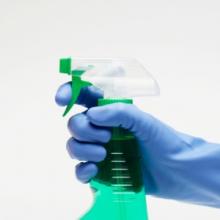Blog Post: 5 ways to reduce your household chemicals

There's nothing nicer than a fresh clean home; we are told from a young age that "cleanliness is next to godliness" and we all know there's no better feeling than getting into a bed with fresh clean sheets, and a house and garden that just smells clean and beautiful.
In this blog I will attempt to discover for all of us as consumers, what household cleaning product options are available that can not be easier on the pocketbook, but also better for your health, your children's health, and for the biosphere as well.
In this first section I will look at attempting to limit exposure to potentially harmful products. From my research it seems that a good number of the products we use to keep our homes clean and fresh may also be potentially very harmful to our health and the environment. Here are some tips to help avoid these health risks and encourage more informed choices when purchasing household products.
1. Minimize burning candles, liquid fuel or incense.
While candles and incense can be great mood-setters, unfortunately their by-products of combustion include carbon monoxide, volatile organic compounds (VOC’s), soot and polycyclic aromatic compounds.
Studies have shown that the concentration of VOC’s can be up to 10 times higher indoors than outdoors. They readily volatilize out of liquid or solid products at home into the air that we breathe, and can cause headaches, nausea and even cancer.
You can read more about VOC's at: http://www.epa.gov/iaq/pubs/hpguide.html#
To reduce the amount of VOC’s you are exposed to, choose products that are lower in VOC’s and be conscious of the choices you make when setting up a new home. For instance, choosing low VOC paints that contain VOC levels of 150g/litre or lower and opting for natural flooring (such as sustainably harvested hardwood, bamboo, tile or cork) instead of synthetic carpets. New carpet can act as a ‘sponge’ for chemical pollutants and can be a source of VOC emissions.
2. Reconsider your cleaning detergents and household chemicals.
The list of potential irritant chemicals in our detergents and cleaners is endless; sulfuric acid in drain cleaners, potassium hydroxide in oven cleaners, formaldehyde in wick deodorizers, and so on. Many are capable of damaging our lungs, eyes or skin through inhalation or contact.
To avoid these risks and to cut back on your inhalation of dangerous chemicals, try using natural ingredients to clean your home.
Here are a few suggestions:
- Instead of ammonia-based cleaners, use baking soda to clean your countertops.
- For lightly clogged drains, heat (not boil) ½ cup of salt in 4 liters of water, and pour it down the drain. If you do buy a cleaning detergent for clogs, avoid buying caustic products.
- For stubborn clogs, pour ½ cup of baking soda down the drain, followed by ½ cup of vinegar. Let it sit for 15 minutes, and then pour in very hot water to clean up the residue.
In addition, here are some tips to make smarter choices about cleaning products that are both friendly for you and the environment:
- Select detergents that are unscented, less toxic and biodegradable.
- Avoid perfumed fabric softeners. They leave residual chemical odors on your clothes, and also pollute the outside air when they are used in the dryer.
- Cut down on the bleach. It gives off noxious fumes and is not environmentally friendly.
- Purchase only what you need. This reduces the need to store hazardous chemicals, paints and solvents at home.
- Substitute disinfectants for a simple combination of detergent and water.
3. Install a central vacuum system in your home.
Not only does this fixture make a significant difference to the air quality in your home, but they also cost less than high-end portable vacuums, but it can also increase your home’s resale value by up to $2000.
Studies have proven that allergy and asthma symptoms can be decreased up to 52% with the installation of a central vacuum system. This is due to the fact that they eliminate noxious odors, indoor toxins, dust and irritants by relocating them to a sealed canister in the basement, instead of simply recycling the allergens back into the air as portable vacuums do.
While the average cost of a central vacuum cleaner is about $1000, it may be well worth it as they last much longer than portable vacuum cleaners (in addition to the benefits mentioned above).
4. Avoid using aerosols and air fresheners.
Scented products have proven to be one of the three biggest sources of chemicals in the home. Just one scent can contain up to almost 500 chemicals! There are many natural alternatives to these devices which can be bronchial irritants. Here are some suggestions:
- Try opening your windows frequently to exchange stale air for fresh air.
- To freshen a room, try emptying a box of baking soda into a bowl and set it out – it will absorb all the odors in the room.
- Tuck bunches of lavender away into drawers, or hang them in rooms for a naturally clean scent. Alternatively, just purchase cloth sachets filled with herbs. Some common fragrance herbs include cinnamon, mint, sandalwood and citrus.
- You can even reduce the odors from cooking by simmering a tablespoon of vinegar in a cup of water on the stove while you are preparing food.
- Most importantly, give your walls a light wash with a damp cloth approximately every 3 to 6 months. This will help reduce dust and can also "remove" lingering odours, instead of masking them with chemicals.
5. Reconsider your choices in pesticides.
These chemicals are common in every household, because they are helpful for pest control and making our lives just that little bit easier. But we often forget or do not realize that certain processes can mean that exactly the opposite is true.
When we spray pesticides into the air, they do not vanish completely – they can move into the food chain where the affects are amplified through the cycle of bio-magnification. As we move up the food chain, the concentration of these chemicals increases and human beings are perched right on top of it. Thus, using pesticides not only puts you and other humans (and animals too) at greater risk of inhaling them, but potentially ingesting them in food as well.
There are several alternatives to the dangers of common pesticides, that help us to limit their use to only when they are absolutely needed.
Consider using natural grade diatomaceous earth. It is a naturally occurring siliceous sedimentary material produced from microscopic skeletal remains of unicellular algae-like plants, diatoms. Even though it is a natural compound, you should avoid continual inhalation of it.
So how does it work? This material essentially acts like a lethal dust with microscopic razor-sharp edges, which cuts against the insects’ protective covering, drying them out. In addition, it shreds their insides if insects ingest it. It can be used on aphids, earwigs, ticks, ants, adult flea beetles, coddling moth, mites, cockroaches, slugs, snails, fungus gnats and many more.
Better yet, this product can be used indoors for pests such as bedbugs, carpet beetles and fly larva. By simply dusting the product (it looks and feels like talcum powder) on the infested areas, your pest problems can be fixed without releasing chemicals into the air.
For natural remedies to target specific bugs and insects, check out this helpful link:
http://eartheasy.com/grow_nat_pest_cntrl.htm
The bottom line remains that you should be aware of what you are dispersing into the air, and the risks you pose to yourself and your family simply through the selection of hazardous products. ^
6. Take the time to read the labels.
Pay close attention to what’s written on product packing labels and seek out natural-based cleaners for your own benefit. The difference in the health of your home will be well worth the time and attention!
A very useful resource to help assist you with the selection of environmentally and health-friendly products is EWG's Skin Deep Cosmetics Database. It gives you safety ratings for a wide range of products and ingredients on the market and is very easy to use. You can check it out at: http://www.ewg.org/skindeep/
Category:


































Comments
Thanks for the ideas Zafira!